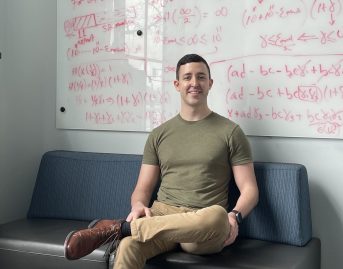Course 1-12 major Ananda Santos Figueiredo pivots from astrophysics to climate change

Born and raised in northeastern Brazil, Ananda Santos Figueiredo came to MIT to study astrophysics. She always had a fascination with astronomy and astrophysics. She appreciates using theoretical thinking and complex problem-solving skills when studying the origin, evolution, and future of the universe.
It wasn’t until the summer before her junior year when she started to think about changing her focus of study. She spent her summer in Washington, DC with the MIT Washington summer internship program working at the World Bank. At the World Bank she conducted research in their data science lab analyzing health outcomes from heat waves in the Philippines. “Every day I would walk into their headquarters doing this incredible work and see this sign hanging on their wall that reads, Our Dream is a World Free of Poverty, and I thought to myself, that is my dream too, how can I help do this?”
The World Bank internship experience shifted her mindset into using her problem-solving skills to improve people’s lives, especially when it comes to equality. When she returned to the MIT campus during fall semester, she started looking for a new major that would fulfill her need to impact people’s lives, but was also flexible, had a lot of career opportunities, and was exciting. Already accepted into the 2023-24 MIT Climate and Sustainability Scholars Program, she thought the new course 1-12 Climate System Science and Engineering major was the best fit. “I like to look at things from a systems perspective and climate change is such a complicated issue connected to many different pieces of our society. I’m in a class right now where they said, ‘there is no silver bullet for climate change, it’s more like a silver shot gun.’”
As soon as Figueiredo made the decision to switch majors, she felt a light bulb moment. “A switch went off and I felt so much weight taken off my shoulders; I’m really happy with the major.”
Figueiredo was the first to declare course 1-12 as her major and started taking classes in fall semester 2023, which was the earliest undergraduates could enroll in the new major. At the same time, she was wrapping up research work in astrophysics, including co-authoring a paper.
She enjoys taking classes in a bunch of different subjects and likes how they all connect with each other. “I think that’s the unique part of this major because it’s so flexible in the way you can customize your course of study.” For example, last fall semester she enjoyed taking 1.018 Fundamentals of Ecology with Associate Professor David Des Marais, then conducting fieldwork in January over IAP (Independent Activities Period) for course 1.091 Traveling Research Environmental Experiences (TREX) led by Des Marais to see firsthand the ecology changes in the island of Hawaii. One of the research projects she worked on during TREX with fellow classmate and course 1-12 major, Lauren Aguilar was measuring the carbon capture by native forests in Hawaii.
She says another reason of her decision to major in course 1-12 is giving back. The same mode of thinking that drew her into studying astrophysics is how she approaches climate change.
“How can we understand where climate change is coming from and where it’s going, but also if we keep things the way they are – inequality is only going to be exacerbated so how can we create solutions that create a shift in mindset and decrease poverty and make the food system better for everyone? Giving back is something I wanted out of my education.”
Learn more about the new Climate System Science and Engineering bachelor’s degree offered by the Departments of Civil and Environmental Engineering (CEE) and Earth, Atmospheric and Planetary Sciences (EAPS) on the degree program’s website at https://climate-major.mit.edu
Share on Bluesky


